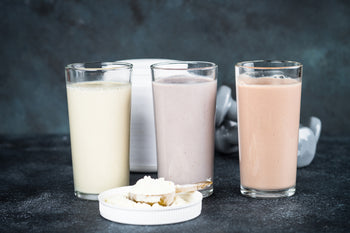 Categories
CategoriesDiet & Exercise
Discover More Articles

It’s no secret that stress can take a toll on our body, mind, and brain. December is not the month to throw your self-care and mental health priorities out the window.

5 Ways to Stay Motivated This Winter
When the seasons change it suddenly becomes harder to get out and exercise. Winter fitness programs aren’t the easiest to stick to, but they’re imperative to your overall health and well-being. So with that in mind, let’s take a look at what you can do to stay motivated and successful with your winter fitness goals.

How to Detox After Holiday Feasts
If you’re having a hard time committing to your diet over the holidays, you’re not alone. And the good news is you don’t have to be perfect to maintain your weight over the holiday season. Try following these simple detox tips after each scrumptious holiday meal and start the new year fresh and ready to finally achieve your health and fitness goals.

High Protein Meal Replacement Shakes
Meal replacement shakes aren’t just low in calories, they’re high in essential nutrients your body needs to keep yourself nourished and your stomach feeling full, while helping also you maintain or lose weight. Protein provides numerous benefits to your body, including fueling the entire body, helping build muscle mass and being a key component to essential substances your body needs, like antibodies and blood.

Skin Cycling: all about the newest trend
The skin cycling hashtag has been viewed over 3 billion times on TikTok—and dermatologists say it's a strategy worth trying.The term "skin cycling" is all about taking a cyclical approach to your facial skincare routine.

Get ready for a plumper, perkier-looking neckline
Meet our new luscious neck cream featuring our proprietary elasticizing bioactive plant blend that targets lines and texture, so your neckline appears smoother, renewed & 10 years younger looking!

TRENDING MAKEUP HACK: BLUSH & BRONZER AS EYESHADOW
By selecting shades that complement each other, you can achieve a harmonious and polished makeup look without the need for multiple products.

5 signs you need more electrolytes
Electrolytes help with hydration by ensuring the body can actually absorb and use the water you drink—preventing dehydration in the presence of sufficient water intake.

Ring In 2025 With ✨ Glowing ✨ Skin…And FREE Boosters!

Better Ingredients, Better You
Your health goals aren’t one-size-fits-all, so your supplements shouldn’t be either. That’s why we designed the Power Line to target different pillars of performance and wellness — from appetite control to anti-aging to athletic power.

Mercury, one of the most dangerous and neurotoxic heavy metals known, has frightened many people into limiting their fish consumption, if not avoiding fish altogether. There is no safe level of mercury, and ocean fish are known to accumulate it, particularly at the highest trophic levels. This problem only continues to grow worse as the oceans become more polluted.
Most government health agencies recommend that pregnant women strictly limit their seafood consumption, out of a legitimate concern that mercury exposure will harm the developing fetal brain (though interestingly, they have no qualms about recommending pregnant women receive the mercury-laden flu shot). But fish are also the primary dietary source of docosahexaenoic acid (DHA), an essential fatty acid absolutely critical for fetal brain development, which has turned fish consumption into a sort of double-edged sword.

Can the benefits of DHA outweigh the potential risks of mercury, especially if one were to consume mostly fish with lower mercury levels? The largest and most recent epidemiological research actually suggests yes, and, in fact, new research into the mechanisms of mercury’s neurotoxicity imply that eating more ocean fish might even help reduce mercury levels in the body due to these foods’ high selenium content.
The latest theory behind mercury’s neurotoxic mechanism involves its interaction with selenium, a trace mineral which forms the basis of the brain’s main antioxidant system. Selenium actually binds to mercury and helps excrete it from the body, and supplementation with selenium has been proven effective for promoting mercury excretion in humans (Li, et al., 2012).
But the process of eliminating mercury will rapidly deplete the body’s selenium stores, rendering it unavailable as an antioxidant and leaving the body more vulnerable to oxidative stress. This especially affects the brain and nervous system because these tissues rely heavily on selenium for their main antioxidant system. It is now believed that mercury exerts its harm by depleting selenium levels, thus making the body and nervous system especially more vulnerable to oxidative stress, and that selenium supplementation can protect against mercury toxicity.
Research on rats has revealed that selenium-deficient diets potentiated the harmful effects of mercury, while diets enriched with selenium and vitamin E were able to mitigate these harmful effects (Beyrouty, et al., 2006). Seafood is in general an excellent source of dietary selenium, and researchers believe this may explain the shockingly inconsistent findings regarding the actual risks of consuming fish during pregnancy.
The first notion that the mercury content of fish might be harmful came from Japan, where people living around Minimata Bay developed symptoms of mercury toxicity that were traced to their high fish consumption. The real cause, however, was soon discovered to be the nearby chemical plant, which was dumping mercury waste into the bay where people fished. These polluted fish were found to contain more than 50 times the mercury concentration of typical ocean fish. Beyond this, there have only been two studies linking fish consumption during pregnancy to adverse effects on fetal neurodevelopment.
These small studies were conducted on populations in New Zealand and the Faroe Islands, where most of the fish consumption was in the form of shark and pilot whale respectively. Granted that pilot whale is not technically a fish, but as far as seafood goes, it has one of the highest mercury concentrations, if not the highest. What is interesting is that, since then, epidemiologists have been unable to replicate these early findings. Many studies, including those on populations from the Seychelles, UK, U.S., and Denmark, have since reached the opposite conclusion, finding that women who consume more fish during pregnancy actually give birth to children with slightly better cognitive outcomes. This is might be due to fish’s high DHA content, the benefits of which seem to outweigh the concerns over mercury content.
What seems to be the crucial factor explaining these conflicting results is not the mercury content of fish, but rather their ratio of neuro-toxic mercury to neuro-protective selenium. Tuna and salmon, for instance, though widely feared, contain 5 to 10 times as much selenium as they do mercury. Given that mercury exerts its toxicity mostly by depleting selenium as an available antioxidant, the favorable ratio found in these fish might actually make them protective against mercury toxicity! It should be remembered that fish is not the only source of mercury exposure, far from it.
One recent study found that fish consumption only accounted for 8.5 percent of the variance in pregnant women’s blood mercury levels, and, in fact, diet as a whole only accounted for 19.8 percent (Golding, et al., 2013).

A diet high in selenium-rich seafood may actually protect against the mercury to which we are all exposed and enhance the body’s capacity to eliminate it, thus acting as a net-positive.
Most types of seafood are very nutritious and provide incredible health benefits, and an extensive review of the best epidemiological research suggests that consuming most types of fish poses little to no danger, even during pregnancy, and, in fact, may even be beneficial (Starling, et al., 2015). What’s important is to choose fish that are high in selenium and low in mercury, which the vast majority of them are.
The list of fish to seriously consider avoiding is actually relatively short. Even the frequently demonized tuna still contains about five times more selenium than mercury, and it would therefore seem to be relatively harmless on the whole. For reference, shark and swordfish, which have some of the highest mercury levels, have a ratio closer to 1:1, and pilot whale is 1:5, definitely one to avoid.
For pregnant women and patients with mercury toxicity concerns, there are undoubtedly certain types of seafood that are best to avoid. The worst in terms of mercury to selenium ratio are shark, swordfish, king mackerel, tilefish, and pilot whale. Energique® also offers some products that can help with mercury detox protocols. Metalstat™ is a homeopathic formula designed to support the body’s heavy metal detox pathways, and our N-Acetyl Cysteine Plus combines selenium synergistically with N-acetyl cysteine, a sulfur-containing amino acid and precursor to glutathione, which is used to chelate mercury in the body.
References
Li YF, Dong Z, Chen C, Li B, Gao Y, Qu L, Wang T, Fu X, Zhao Y, Chai Z. Organic selenium supplementation increases mercury excretion and decreases oxidative damage in long-term mercury-exposed residents from Wanshan, China. Environmental Science and Technology. 2012 Oct 16;46(20):11313-8. doi: 10.1021/es302241v. Epub 2012 Oct 3.
Beyrouty P, Chan M. Co-consumption of selenium and vitamin E altered the reproductive and developmental toxicity of methylmercury in rats. Neurotoxicology and Teratology. 2006 Jan-Feb;28(1):49-58.
Golding J, Steer CD, Hibbeln JR, Emmett PM, Lowery T, Jones R. Dietary predictors of maternal prenatal blood mercury levels in the ALSPAC birth cohort study. Environmental Health Perspectives. 2013;121(10):1214-8.
Starling P, Charlton K, McMahon AT, Lucas C. Fish intake during pregnancy and foetal neurodevelopment–a systematic review of the evidence. Nutrients. 2015;7(3):2001-14. Published 2015 Mar 18. doi:10.3390/nu7032001
Any homeopathic claims are based on traditional homeopathic practice, not accepted medical evidence. Not FDA evaluated.
These statements have not been evaluated by the Food and Drug Administration. These products are not intended to diagnose, treat, cure, or prevent any disease.
